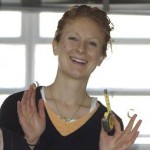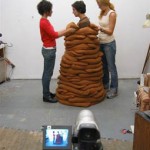The Berwick Research Institute is in a time of transition. Director Meg Rotzel has stepped down from her leadership role, and although she is still working on several projects at The Berwick, much of the programming is under new direction. Most notably, their flagship Artist In Research (AIR) residency is now under the guidance of Bonnie Bastien and Rosie Branson Gill.
Recently, we sat down for coffee to discuss the AIR program's past and future, and their plans for this important resource.
MN: So, you are taking over the incredible and somewhat insane Berwick AIR program?
RBG: Yes! It's true.
BB: This is our first official year as a team after spending last year learning the ropes.
MN: So what’s on the schedule? What’s new? What’s shiny?
BB: There aren’t many things “new”. It’s more that we’re really excited to run the program well and engage with the artist and the work, documenting the process all the way through.
RBG: We want to fix the quirks from last year. We're comfortable in our own skins now, so as curators I feel like we are standing on four very firm feet, a stability that gives us the freedom to look around and evaluate the program. There are some changes we will make, but they are all very small and basic. For example, the vocabulary of the program needs some attention. We are not particularly fond of our title; we don't feel we are curators, but we haven't figured out what a good replacement may be. For this first year, we'll be thinking about things like that. We are starting with a very good program, so we don't want to rush to change things just for the sake of changing.
MN: What are the quirks that you think need to be adjusted?
RBG: Documentation.
BB: Yeah, we have a whole lot of tech quirks that are being taken care of as we speak. The Berwick and the AIR program exist entirely on a website. We don’t have a public location anymore and so we rely heavily on our web presence and word-of-mouth. The Berwick is working courageously to have a new website up and running for the first 2007 AIR residency in April. It's gonna be great!
MN: So what artists will you be working with in 2007?
RBG: We don’t know yet.
BB: We will get all the applications this week, and our first jury happens on the sixteenth of February.
RBG: We’re trying to notify all the artists by March first. We know we have applicants all over the world. We’re really excited to see what comes in.
MN: In the past, I know that the Berwick has done shows at the BCA, and the Busycle got a lot of attention. Is that the plan for the future, to do more group shows and look for venues to highlight the work?
BB: Do you mean The Berwick, or the AIR program?
RBG: That is one of the quirks we’re trying to work out. People tend to conflate The Berwick and AIR, and we’re just one part of The Berwick, and that’s one of the things we want to change. We’re our own little entity, under the umbrella of The Berwick, but there are other programs and other things going on. We may partake in group shows, we might curate group shows. One of our goals is to get our name out there, to be in conferences and to get into international residency circles. We need to say “Hey, we are the AIR program, this is what we do!”
MN: Can you define what you see as the function of the AIR program, and how that is separate from the larger role of The Berwick? I think even many of us who are close to The Berwick tend to conflate the two.
BB: The Berwick Research Institute is a non-profit that creates and financially sponsors programming that supports artists working in "new genres" such as electronics, sound, installation, performance, and media- and time-based art. Usually these projects are highly conceptual and the artists are in need of an artistic community to support investigation and dialogue. The AIR Program is just one of the programs that the Berwick has created. In addition to our program, there is a program called "Meet Me at the Table" which is itself researching public art in Boston. There are also many smaller scale projects that the Berwick supports but we all come together under the same conceptual umbrella of the Berwick.
RBG: Our program is the Artist in Research Program which is an artist residency. The mission of the AIR program is to provide artists with the time, space and critical feedback - this is verbatim from our application - for researching a project. That’s where we are different from other residencies in a very important way, we don’t demand an end product. We demand an extremely careful and considered reflection within the artistic process, as it is focused on one project.
MN: So do you see the larger function of The Berwick as a whole as taking that work, as well as artists who may have never done AIR, and getting it out into the world?
RBG: The larger function of The Berwick is complimentary to the AIR program. It’s about process and research, not needing very polished and well-designed end products, but getting people to talk to each other when they are at a point of discovery. That’s what we do. We have studio space for creation and research, not necessarily end products.
The new program, hopefully coming this year, is the same thing – it’s about getting people to talk about projects as they develop. I think that we share that spirit.
BB: The AIR program is very narrow. We only work with three artists per year, so The Berwick trying to expand and create other pilot projects that reach out further so The Berwick isn’t something that’s a closed entity.
RBG: Heather Kapplow explained it really well at our last board meeting. She said that, as opposed to having The Berwick be about a space, because there are a ton of reasons why identifying with Dudley Square is a fallacy on our part, we should make it sort of a smell. That’s how she put it. We’re going to make it a smell that permeates through Boston, and when you catch a whiff of it you know that this is Berwick.
MN: Focusing on AIR, I have noticed that the average age of people who do the AIR program is very young. Is this a decision on your part, or an accident, or one of those quirks that you want to work out?
BB: I’d never thought of that, but you’re right. We work with exactly what we get in, from our pool of applicants.
MN: If you’re working with what you’re getting, does that mean that the AIR program appeals to a certain age group?
BB: Yes, but I would say too that when we put out our calls, it is heavily saturated in art schools, and people coming right out of school are looking for residencies, so we get a lot of those. Some of the projects are amazing.
RBG: In some respects, I think it’s intentional that we get artists at the beginning of their career. Not IN school, we don’t want undergraduates, but we want people who aren’t yet established. We give artists who are coming into their own time to form their ideas about why they make art and how to make carefully considered choices in the art-making process. If we had a forty-year-old artist who wanted to apply, great! welcome! but it does tend to be younger artists who seek out our help.
BB: I think it would be a great experience to have a more mature exploration.
MN: I can imagine that there are artists who have reached a certain place and want to push their ideas along. A lot of people go back to school for that, they get a Master’s degree or something like that. To be able to kick-start the process in another way, though, in a 10 week residency, would be great for a lot of people. I can imagine later in my career doing something like that.
BB: If someone brought a project to us and said “This is what I usually do, but I have this crazy idea that’s going in a whole new direction …” that’s what we love. Our job is to pull them out of their comfort zone and push that new direction of thought. That’s what we do here.
- Rosie Branson Gill
- Bonnie Bastien
- Working with AIR researcher Veronique d’Entremont
Links:
Berwick Research Institute
Images courtesy of Rosie Branson Gill and Bonnie Bastien.
Photo of Veronique D'Entremont courtesy of the artist and The Berwick.







